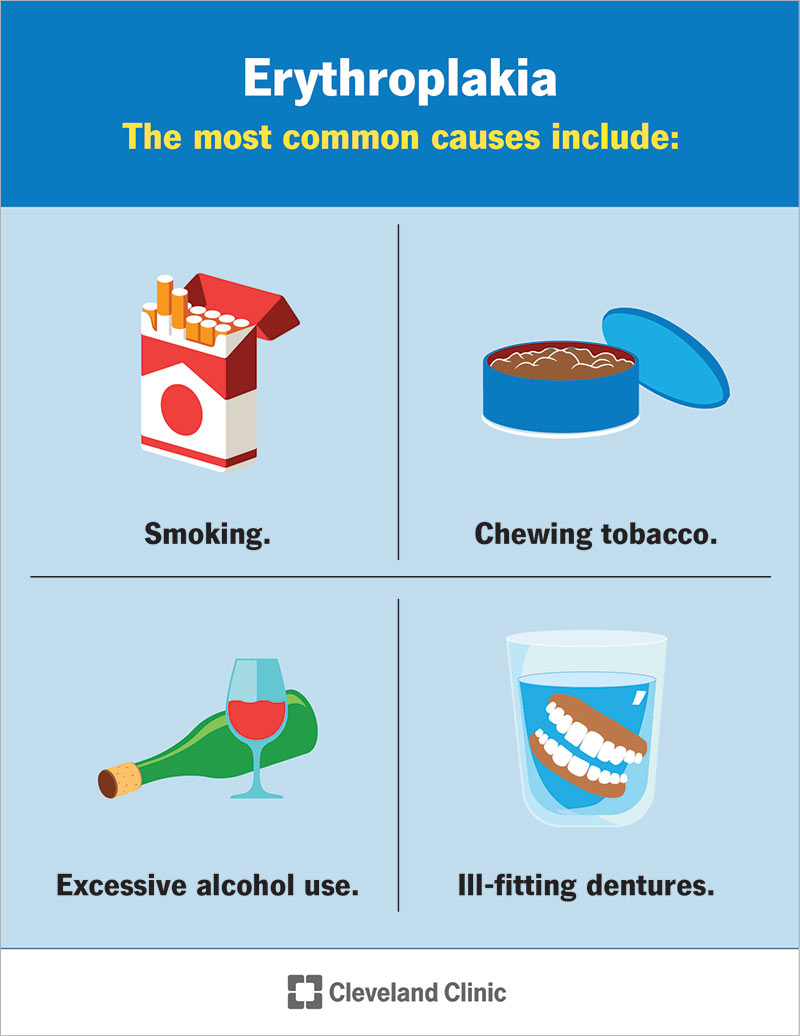Erythroplakia affects the mucous membranes of your mouth. It causes red lesions (spots) that may appear in combination with white patches (leukoplakia). Erythroplakia may be cancerous or noncancerous. Smoking and chewing tobacco use are the leading causes of erythroplakia. To determine treatment, your healthcare provider will likely take a biopsy.
Advertisement
Cleveland Clinic is a non-profit academic medical center. Advertising on our site helps support our mission. We do not endorse non-Cleveland Clinic products or services. Policy

Erythroplakia (pronounced “eh-RITH-roh-PLAY-kee-uh”) is a condition that affects the soft tissue lining of your mouth and throat. It causes red lesions (patches) to appear on your oral mucous membranes, including your tongue, inner cheeks or floor of your mouth.
Advertisement
Cleveland Clinic is a non-profit academic medical center. Advertising on our site helps support our mission. We do not endorse non-Cleveland Clinic products or services. Policy
While most erythroplakia lesions are harmless, some are cancerous. For this reason, you should tell a healthcare provider about any abnormal areas in your mouth.
Anyone can get erythroplakia. But it’s more common in people who smoke or use chewing tobacco. It’s also more likely to affect people over the age of 40.
Erythroplakia is less common than leukoplakia, affecting around 1 out of every 2,500 adults in the U.S.
Healthcare providers consider erythroplakia a precancerous condition. While most lesions are harmless, some are cancerous or have the potential to become cancerous. If you notice any abnormal lesions in your mouth, schedule an appointment with a healthcare provider or dentist right away. They’ll perform a biopsy to determine whether the lesion is cancerous.
People with erythroplakia don’t always have pain or other warning signs. Visual erythroplakia symptoms may include:
The most common erythroplakia causes include:
Additionally, erythroplakia lesions may develop as a secondary infection alongside candidiasis (an oral fungal infection called thrush). Sometimes, people develop erythroplakia without a clear cause.
Advertisement
You have a higher risk of developing erythroplakia if you:
Because erythroplakia doesn’t always cause pain or other symptoms, the condition often goes unnoticed until your dentist discovers it during a routine oral health exam. If your dentist notices areas of concern, they’ll take a biopsy. During this procedure, your provider will take a small sample of the affected tissue and send it to a lab for analysis.
A biopsy can also help your provider rule out other conditions that exhibit similar conditions, such as:
Erythroplakia treatment depends on the findings of your biopsy. If your case is mild and noncancerous, your healthcare provider may simply monitor the condition with frequent follow-up visits. If erythroplakia is severe, recurring or cancerous, your provider may pursue treatment for erythroplakia, such as:
Recovery after erythroplakia treatment varies depending on several factors, including the type of surgery done, the size of the lesion and your body’s healing capacity. In general, most people fully recover from laser therapy or cryotherapy in three to four weeks. For people who undergo cancer treatments, full recovery could take several weeks or months. Ask your healthcare provider what to expect in your situation.
Erythroplakia is a potentially precancerous condition. But most people who have erythroplakia don’t go on to develop cancer. Still, it’s important to schedule an appointment with a healthcare provider so they can determine a diagnosis and treatment plan, if any.
Sometimes, erythroplakia goes away on its own. But if you have severe or recurrent erythroplakia, your provider may recommend treatment with laser therapy or cryotherapy.
If your biopsy results show cancer, then your healthcare provider will refer you to an oncologist for further testing and treatment.
While many people don’t experience pain with erythroplakia, some may develop soreness or sensitivity to hot and spicy foods. Use discretion and avoid foods and beverages that cause symptoms to flare.
Sometimes, erythroplakia develops without a known cause. Therefore, it’s not always possible to prevent it altogether.
Advertisement
But there are things you can do to reduce your risk for erythroplakia, including:
Any time you notice sores, lesions or other abnormalities in your mouth, schedule an appointment with a dentist or healthcare provider. It’s important to have an evaluation so your provider can rule out other, serious health issues and give you a proper diagnosis.
If you have erythroplakia, here are some questions you may want to ask your healthcare provider:
Erythroplakia lesions often occur alongside white patches. These white patches are leukoplakia, another condition affecting your oral soft tissues.
Erythroplakia lesions are red areas (raised or flat) that may bleed easily when touched or scraped. Leukoplakia lesions are white patches that don’t come off when you scrape them.
Advertisement
Erythroplakia causes red, patchy lesions in your mouth or throat. While it’s not harmful most of the time, it’s a potentially precancerous condition. If you notice sores or lesions in your mouth, you should see your dentist or healthcare provider right away. They can determine if you have erythroplakia and whether you’ll need treatment.
Advertisement
Cleveland Clinic’s primary care providers offer lifelong medical care. From sinus infections and high blood pressure to preventive screening, we’re here for you.

Last reviewed on 01/11/2023.
Learn more about the Health Library and our editorial process.